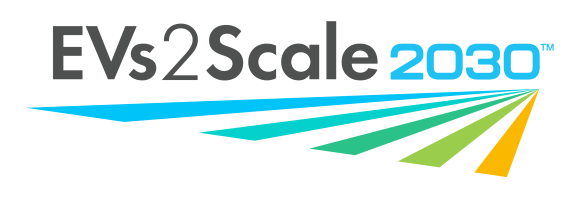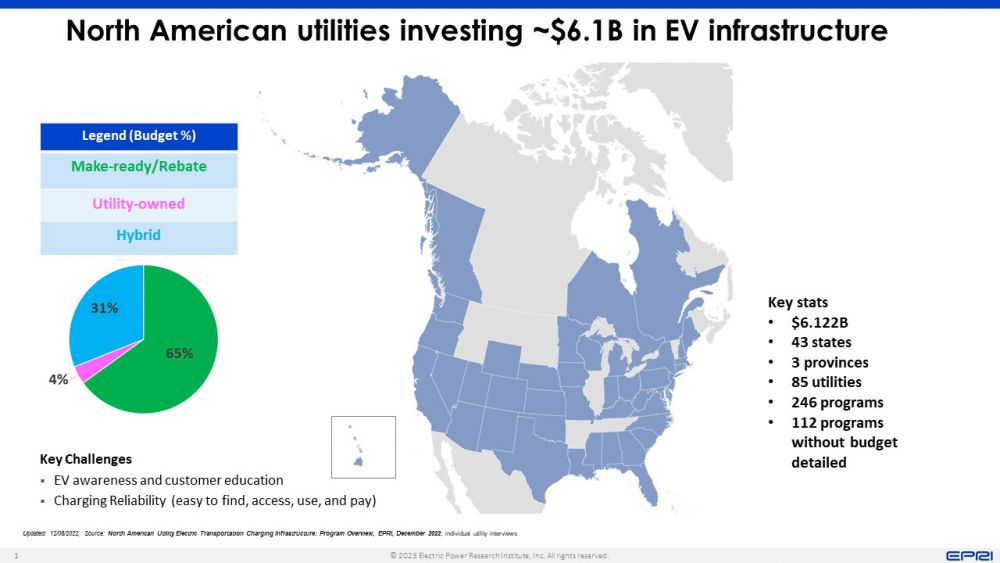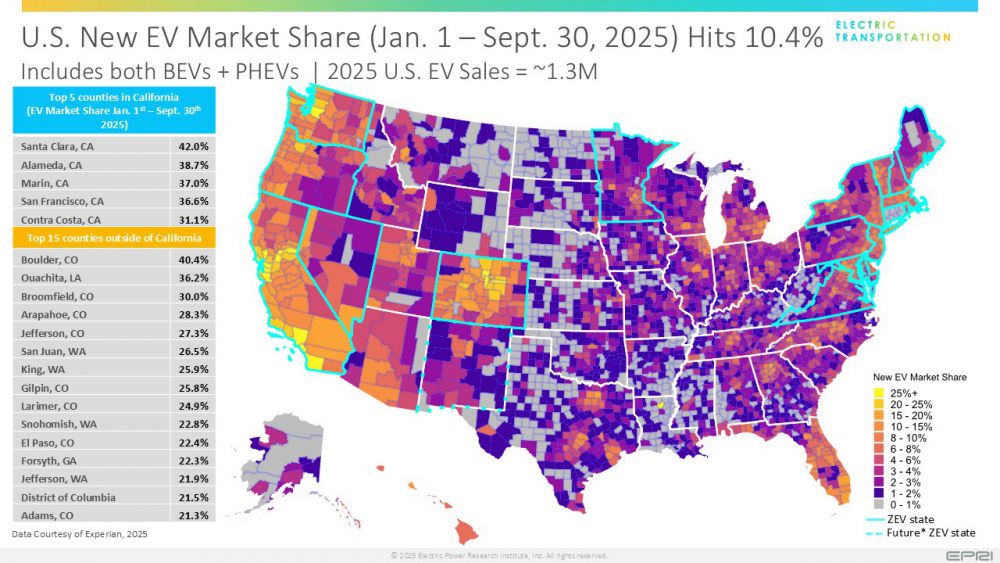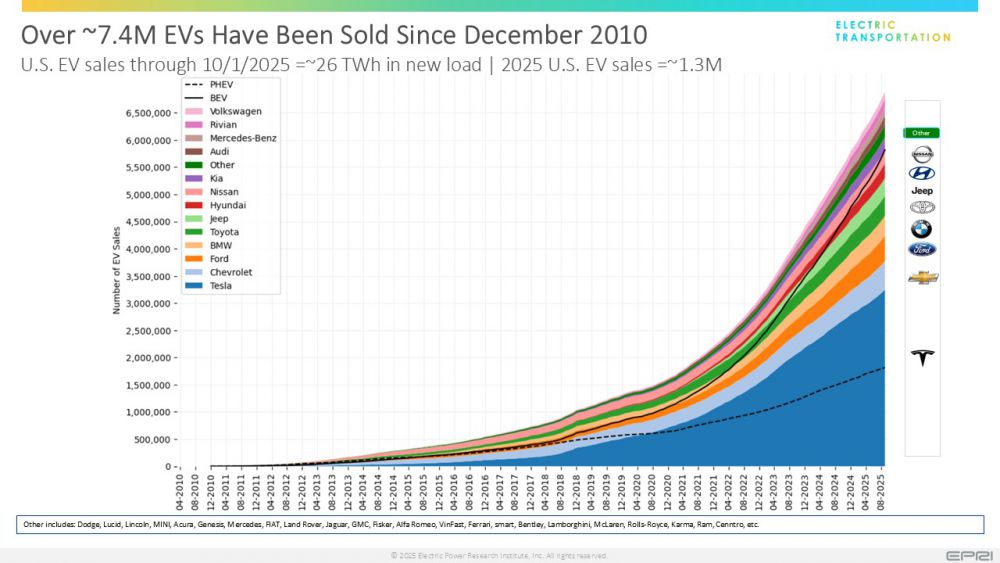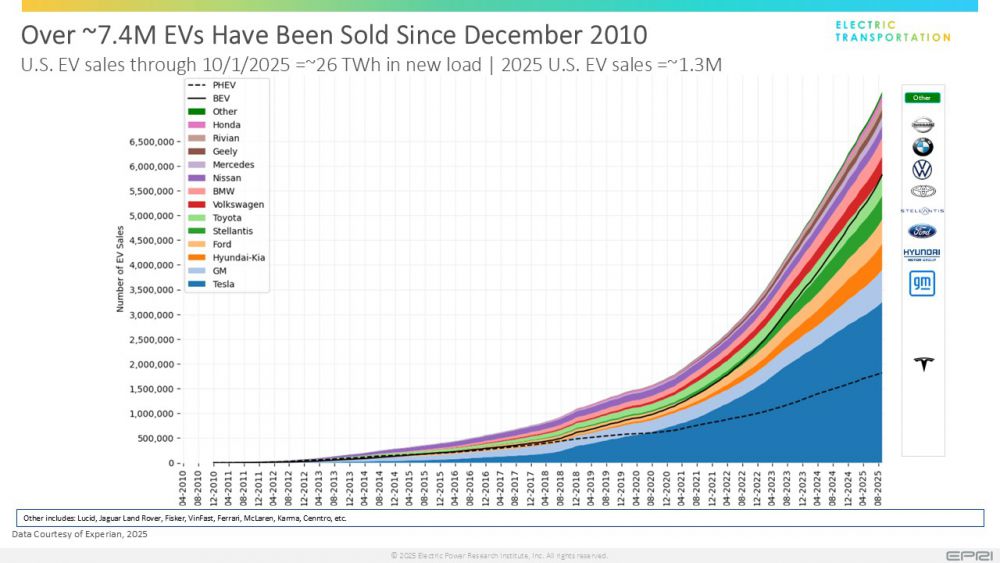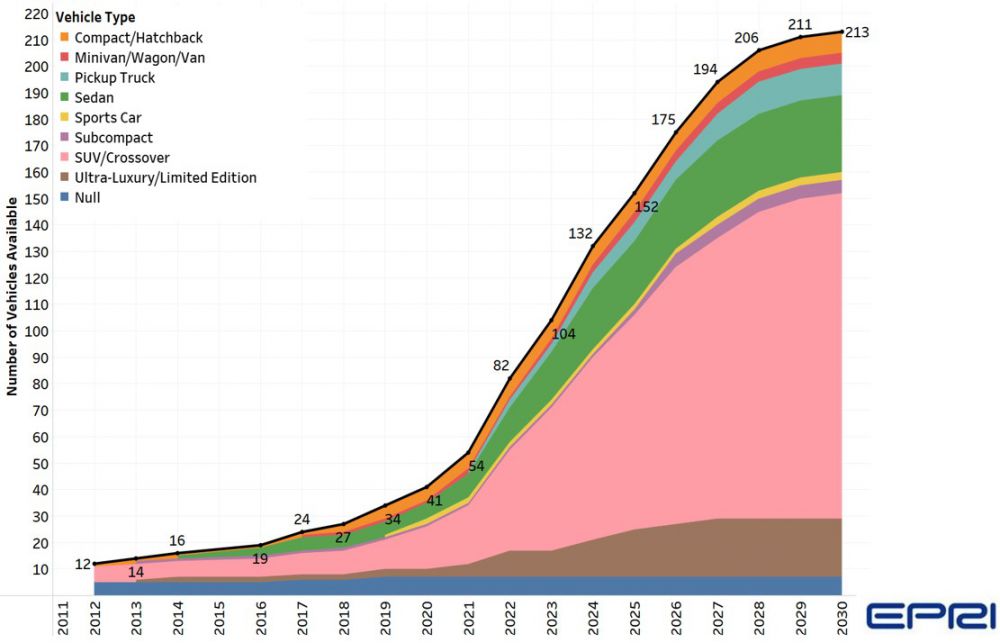Difference between revisions of "Welcome to Electric Transportation Wiki"
(→�) |
|||
| (140 intermediate revisions by the same user not shown) | |||
| Line 1: | Line 1: | ||
Welcome to the main page of the [https://www.epri.com/about Electric Power Research Institute's] Electric Transportation Wiki, a wiki-style hub for Electric Transportation research at EPRI. | |||
[https://www.epri.com/research/programs/053122 Electric Transportation] falls under the Electrification and Customer Solutions section of the Electric Power Research Institute's (EPRI) [https://www.epri.com/research/sectors/pdu Power Delivery & Utilization] sector, which, "provides transmission, distribution, and end use R&D to guide utilities and stakeholders toward a safe, secure, resilient, affordable, reliable and environmentally responsible, integrated grid." | |||
EPRI is a non-profit organization. Find out more about EPRI's history and business [https://www.epri.com/about here]. | |||
==EVs2Scale2030== | |||
EPRI’s EVs2Scale2030™ initiative is a three-year commitment focused on leveraging industry scale to galvanize not only the utility industry, but to align all critical market stakeholders as electric vehicle goals increasingly target 50 percent new vehicle sales by 2030. EPRI will leverage its industry partnerships to mobilize utilities, fleet operators, the automotive industry, and charging providers, and coordinate with federal agencies and labs, to support the rapid deployment of millions of electric vehicles – while minimizing grid impacts and enabling critical benefits to the nation’s grid. | |||
Learn more [https://msites.epri.com/evs2scale2030 here]. | |||
[[File:EV2S2030 568.png|1000px|thumb|center]] | |||
==Utility Investments== | |||
In order to support significant EV adoption, the appropriate infrastructure needs to be in place. This requires substantial investments across all sectors of the industry. Over time, the ET team has tracked infrastructure investments committed by utilities. | |||
Are we missing your utility's infrastructure investments? If so, please [mailto:dbowermaster@epri.com contact us]. | |||
[[File:Utility_EV_Infrastructure_Investments_Map_No_Logos_for_Wiki_(002).jpg|1000px|thumb|center|Based on individual utility interviews as of December 2022]] | |||
{| class="wikitable" style="margin-left: auto; margin-right: auto; border: none;" | |||
! Name of Utility !! Sum of Budget (in millions) | |||
|- | |||
| Algonquin Power & Utilities Corporation || $19.40 | |||
|- | |||
| ALLETE, Inc. || $6.20 | |||
|- | |||
| Ameren Corporation (Missouri) || $11.00 | |||
|- | |||
| American Electric Power (includes Appalachian Power Company & Indiana Michigan Power) || $13.05 | |||
|- | |||
| Arizona Public Service Company || - | |||
|- | |||
| Austin Energy - City of Austin Utilities || - | |||
|- | |||
| Avangrid, Inc. || $180.55 | |||
|- | |||
| Bear Valley Electric Service, Inc. || $0.70 | |||
|- | |||
| Berkshire Hathaway Energy Company || $227.20 | |||
|- | |||
| British Columbia Hydro and Power Authority || $44.80 | |||
|- | |||
| City of Anaheim Public Utilities || $0.67 | |||
|- | |||
| Consolidated Edison, Inc. || $217.05 | |||
|- | |||
| Consumers Energy || $22.20 | |||
|- | |||
| Dawson Public Power District (NE) || - | |||
|- | |||
| DTE Energy (formerly Detroit Edison Energy Company) || $44.30 | |||
|- | |||
| Duke Energy Corporation || $108.80 | |||
|- | |||
| Duquesne Light Company || $1.50 | |||
|- | |||
| Edison International || $867.60 | |||
|- | |||
| Emera, Inc. || $2.30 | |||
|- | |||
| Entergy Corporation || - | |||
|- | |||
| Evergy, Inc. (formerly Kansas City Power & Light) || $1.10 | |||
|- | |||
| Eversource Energy || $320.10 | |||
|- | |||
| Exelon Corporation || $110.25 | |||
|- | |||
| FirstEnergy Corporation || $39.90 | |||
|- | |||
| Fortis Inc. || $200.25 | |||
|- | |||
| Greenville Utilities Commission (NC) || $0.03 | |||
|- | |||
| Hawaiian Electric Industries, Inc. || $93.51 | |||
|- | |||
| Holland Board of Public Works (MI) || - | |||
|- | |||
| Hydro-Québec || $450.00 | |||
|- | |||
| Hyrdo One Limited || $5.60 | |||
|- | |||
| IDACORP, Inc. || - | |||
|- | |||
| Los Angeles Department of Water and Power || $452.40 | |||
|- | |||
| Madison Gas and Electric Company || - | |||
|- | |||
| Narragansett Electric Company (currently Rhode Island Energy) || $11.50 | |||
|- | |||
| National Grid Public Limited Company || $650.25 | |||
|- | |||
| Nebraska Public Power District (NE) || - | |||
|- | |||
| New York Power Authority (Power Authority of the State of New York) || $250.00 | |||
|- | |||
| NextEra Energy, Inc. || $205.00 | |||
|- | |||
| Omaha Public Power District (NE) || - | |||
|- | |||
| Otter Tail Corporation || $2.10 | |||
|- | |||
| Pacific Gas & Electric Company || $725.90 | |||
|- | |||
| Portland General Electric || $28.90 | |||
|- | |||
| PPL Corporation || $0.50 | |||
|- | |||
| Public Service Company of New Mexico || $8.70 | |||
|- | |||
| Public Service Enterprise Group || $292.70 | |||
|- | |||
| Puget Sound Energy || $15.50 | |||
|- | |||
| Roseville Electric Utility (CA) || - | |||
|- | |||
| Seattle City Light || $4.30 | |||
|- | |||
| Sempra Energy || $234.90 | |||
|- | |||
| Southern Company || $37.89 | |||
|- | |||
| The AES Corporation || $10.90 | |||
|- | |||
| UNS Energy Corporation || $2.20 | |||
|- | |||
| We Energies || - | |||
|- | |||
| Xcel Energy Inc. || $146.90 | |||
|- | |||
| <strong> Grand Total <strong/> || <strong> $6,069.09 <strong/> | |||
|} | |||
==New EV Market Share Heat Maps== | |||
The ET team tracks market share of new EVs nationwide, by state, and by county. This does not include used vehicle sales. Our heat maps support a strengthened understanding of the growth of EV sales as well as charging infrastructure. | |||
[[File:US Nationwide New EV Market Share (Jan. 1 - Sept. 30, 2025).jpg|1000px|thumb|center|Analysis of Experian data]] | |||
<!--[[File:- of Connectors per 1,000 population by County (through Oct. 29, 2024 AFDC).jpg|1000px|thumb|center|Courtesy of the Alternative Fuels Data Center (As of Oct. 2024)]]--> | |||
<!--[[File:- of Connectors per sq mile by County (through Oct. 29, 2024 AFDC).jpg|1000px|thumb|center|Courtesy of the Alternative Fuels Data Center (As of Oct. 2024)]]--> | |||
==EV Sales and Availability== | |||
The EV industry is steadily growing. We are tracking the availability of vehicle types and expecting the industry to grow further. By 2024, more than 130 models are projected to be available for US consumers. This is a vast improvement from the year 2010 in which only 2 models were available. | |||
[[File:EV_Sales_Sept_2025.jpg|1000px|thumb|center|Analysis of InsideEVs and Experian data as of October 2025]] | |||
[[File:EV_Sales_Sept_2025_(OEM).jpg|1000px|thumb|center|Analysis of InsideEVs and Experian data as of October 2025]] | |||
[[File:Vehicle Type Over Time (Nov 2025) with logo.jpg|1000px|thumb|center|Based on EPRI Consumer Guide data as of November 2025]] | |||
<!--[[File:Vehicle_Type_Over_Time_(Nov_2024)_with_logo.JPG|1000px|thumb|center|Based on EPRI Consumer Guide data as of November 2024]]--> | |||
==Current and Planned Electric Transportation Wiki Content== | |||
EPRI has publications that are available the public as well as some that are only available to utility members. Please see below for a listing of publications over the last few years on a range of EV related topics. | |||
{|class="wikitable" | {|class="wikitable" | ||
|- | |- | ||
! | !Content | ||
! | !Description | ||
! | !Access | ||
|- | |- | ||
| | |<div style="text-align:center;"><span class="plainlinks"><font color="002bb8"><strong>[http://etwiki.epri.com/About_Us About Us]</strong></font></span></div> | ||
|Highlights of EPRI ET's numerous milestones and successes and a description of our approaches to research. | |||
| | |Public | ||
| | |- | ||
|<div style="text-align:center;"><span class="plainlinks"><font color="002bb8"><strong>[http://etwiki.epri.com/Electric_Transportation_101 Electric Transportation 101]</strong></font></span></div> | |||
|A list of industry facts and the benefits of electric transportation. | |||
|Public | |||
|- | |||
|<div style="text-align:center;"><span class="plainlinks"><font color="002bb8"><strong>[http://etwiki.epri.com/Quick_Takes:_What_You_Need_to_Know Quick Takes: What You Need to Know]</strong></font></span></div> | |||
|A collection of perspectives to the myriad of major EV headlines, topics, and challenges. | |||
|Public and Members | |||
| | |- | ||
|<div style="text-align:center;"><span class="plainlinks"><font color="002bb8"><strong>[http://etwiki.epri.com/Case_Studies Case Studies]</strong></font></span></div> | |||
|A collection of case studies that have been conducted by the EPRI Electric Transportation team. These case studies seek to explore and demonstrate various scenarios and methods of research. | |||
|Public and Members | |||
|- | |- | ||
|<div style="text-align:center;"><span class="plainlinks"><font color="002bb8"><strong>[http://etwiki.epri.com/Consumer_Guides Consumer Guides]</strong></font></span></div> | |||
|A collection of consumer guides that cover the state of the market across various topics and detail consumers' options. | |||
|Members | |||
|- | |- | ||
| | |<div style="text-align:center;"><span class="plainlinks"><font color="002bb8"><strong>[http://etwiki.epri.com/Newsletters Newsletters]</strong></font></span></div> | ||
|Quarterly newsletters that update members with ongoing efforts as well as insights into future activities of EPRI's Electric Transportation Program. | |||
|Members | |||
| | |||
| | |- | ||
|<div style="text-align:center;"><span class="plainlinks"><font color="002bb8"><strong>[http://etwiki.epri.com/Presentations Presentations]</strong></font></span></div> | |||
|A collection of presentations that have been given within EPRI and to outside organizations. | |||
|Members | |||
|- | |- | ||
|<div style="text-align:center;"><span class="plainlinks"><font color="002bb8"><strong>[http://etwiki.epri.com/Technical_Briefs Technical Briefs]</strong></font></span></div> | |||
|A collection of short publications that summarize key findings from the ET team. | |||
|Members | |||
|- | |- | ||
| | |<div style="text-align:center;"><span class="plainlinks"><font color="002bb8"><strong>[https://etwiki.epri.com/Software_and_Tools Software and Tools]</strong></font></span></div> | ||
|A collection of software and tools developed by the ET team. | |||
|Members | |||
| | |- | ||
|<div style="text-align:center;"><span class="plainlinks"><font color="002bb8"><strong>[http://etwiki.epri.com/Technical_Reports Technical Reports]</strong></font></span></div> | |||
|A collection of reports covering research findings in more detail. | |||
|Public and Members | |||
|- | |- | ||
|<div style="text-align:center;"><span class="plainlinks"><font color="002bb8"><strong>[http://etwiki.epri.com/Electric_Transportation_Working_Groups Electric Transportation Working Groups]</strong></font></span><div> | |||
|A collection of materials prepared for and/or by the Infrastructure Working Council (IWC) and the Bus and Truck Working Council. These EPRI-sponsored groups identify and prioritize related issues and collaborate to provide recommendations. | |||
|Members | |||
|} | |} | ||
<strong> | ==Research Results and Supplemental Projects== | ||
To see the full list of ET deliverables (back to 2015), visit our [http://etwiki.epri.com/Research_Results_and_Supplemental_Projects Research Results and Supplemental Projects] page. | |||
<strong>EPRI's Comprehensive Electric Transportation Expertise</strong> | |||
The experts in EPRI's Electric Transportation program conduct in-depth research on these and other critical issues. EPRI's comprehensive research, data, and tools can help utilities expedite actions to achieve their EV-related goals—whether they have recently started engaging with the EV market or are long-time market participants. | |||
The program also gathers key insights through its collaboration among utilities, automakers, charging infrastructure companies, and other major national and international EV industry stakeholders. Utilities can use EPRI's comprehensive suite of resources to help them serve as their customers' trusted EV advisors, and to inform their short- and long-term investment decisions to help enable reliable, safe, affordable, and environmentally responsible electricity. | |||
Please [mailto:askepri@epri.com contact us] with any questions about our research. | |||
Latest revision as of 14:23, 1 December 2025
Welcome to the main page of the Electric Power Research Institute's Electric Transportation Wiki, a wiki-style hub for Electric Transportation research at EPRI.
Electric Transportation falls under the Electrification and Customer Solutions section of the Electric Power Research Institute's (EPRI) Power Delivery & Utilization sector, which, "provides transmission, distribution, and end use R&D to guide utilities and stakeholders toward a safe, secure, resilient, affordable, reliable and environmentally responsible, integrated grid."
EPRI is a non-profit organization. Find out more about EPRI's history and business here.
EVs2Scale2030
EPRI’s EVs2Scale2030™ initiative is a three-year commitment focused on leveraging industry scale to galvanize not only the utility industry, but to align all critical market stakeholders as electric vehicle goals increasingly target 50 percent new vehicle sales by 2030. EPRI will leverage its industry partnerships to mobilize utilities, fleet operators, the automotive industry, and charging providers, and coordinate with federal agencies and labs, to support the rapid deployment of millions of electric vehicles – while minimizing grid impacts and enabling critical benefits to the nation’s grid.
Learn more here.
Utility Investments
In order to support significant EV adoption, the appropriate infrastructure needs to be in place. This requires substantial investments across all sectors of the industry. Over time, the ET team has tracked infrastructure investments committed by utilities.
Are we missing your utility's infrastructure investments? If so, please contact us.
| Name of Utility | Sum of Budget (in millions) |
|---|---|
| Algonquin Power & Utilities Corporation | $19.40 |
| ALLETE, Inc. | $6.20 |
| Ameren Corporation (Missouri) | $11.00 |
| American Electric Power (includes Appalachian Power Company & Indiana Michigan Power) | $13.05 |
| Arizona Public Service Company | - |
| Austin Energy - City of Austin Utilities | - |
| Avangrid, Inc. | $180.55 |
| Bear Valley Electric Service, Inc. | $0.70 |
| Berkshire Hathaway Energy Company | $227.20 |
| British Columbia Hydro and Power Authority | $44.80 |
| City of Anaheim Public Utilities | $0.67 |
| Consolidated Edison, Inc. | $217.05 |
| Consumers Energy | $22.20 |
| Dawson Public Power District (NE) | - |
| DTE Energy (formerly Detroit Edison Energy Company) | $44.30 |
| Duke Energy Corporation | $108.80 |
| Duquesne Light Company | $1.50 |
| Edison International | $867.60 |
| Emera, Inc. | $2.30 |
| Entergy Corporation | - |
| Evergy, Inc. (formerly Kansas City Power & Light) | $1.10 |
| Eversource Energy | $320.10 |
| Exelon Corporation | $110.25 |
| FirstEnergy Corporation | $39.90 |
| Fortis Inc. | $200.25 |
| Greenville Utilities Commission (NC) | $0.03 |
| Hawaiian Electric Industries, Inc. | $93.51 |
| Holland Board of Public Works (MI) | - |
| Hydro-Québec | $450.00 |
| Hyrdo One Limited | $5.60 |
| IDACORP, Inc. | - |
| Los Angeles Department of Water and Power | $452.40 |
| Madison Gas and Electric Company | - |
| Narragansett Electric Company (currently Rhode Island Energy) | $11.50 |
| National Grid Public Limited Company | $650.25 |
| Nebraska Public Power District (NE) | - |
| New York Power Authority (Power Authority of the State of New York) | $250.00 |
| NextEra Energy, Inc. | $205.00 |
| Omaha Public Power District (NE) | - |
| Otter Tail Corporation | $2.10 |
| Pacific Gas & Electric Company | $725.90 |
| Portland General Electric | $28.90 |
| PPL Corporation | $0.50 |
| Public Service Company of New Mexico | $8.70 |
| Public Service Enterprise Group | $292.70 |
| Puget Sound Energy | $15.50 |
| Roseville Electric Utility (CA) | - |
| Seattle City Light | $4.30 |
| Sempra Energy | $234.90 |
| Southern Company | $37.89 |
| The AES Corporation | $10.90 |
| UNS Energy Corporation | $2.20 |
| We Energies | - |
| Xcel Energy Inc. | $146.90 |
| Grand Total | $6,069.09 |
The ET team tracks market share of new EVs nationwide, by state, and by county. This does not include used vehicle sales. Our heat maps support a strengthened understanding of the growth of EV sales as well as charging infrastructure.
EV Sales and Availability
The EV industry is steadily growing. We are tracking the availability of vehicle types and expecting the industry to grow further. By 2024, more than 130 models are projected to be available for US consumers. This is a vast improvement from the year 2010 in which only 2 models were available.
Current and Planned Electric Transportation Wiki Content
EPRI has publications that are available the public as well as some that are only available to utility members. Please see below for a listing of publications over the last few years on a range of EV related topics.
| Content | Description | Access |
|---|---|---|
| Highlights of EPRI ET's numerous milestones and successes and a description of our approaches to research. | Public | |
| A list of industry facts and the benefits of electric transportation. | Public | |
| A collection of perspectives to the myriad of major EV headlines, topics, and challenges. | Public and Members | |
| A collection of case studies that have been conducted by the EPRI Electric Transportation team. These case studies seek to explore and demonstrate various scenarios and methods of research. | Public and Members | |
| A collection of consumer guides that cover the state of the market across various topics and detail consumers' options. | Members | |
| Quarterly newsletters that update members with ongoing efforts as well as insights into future activities of EPRI's Electric Transportation Program. | Members | |
| A collection of presentations that have been given within EPRI and to outside organizations. | Members | |
| A collection of short publications that summarize key findings from the ET team. | Members | |
| A collection of software and tools developed by the ET team. | Members | |
| A collection of reports covering research findings in more detail. | Public and Members | |
| A collection of materials prepared for and/or by the Infrastructure Working Council (IWC) and the Bus and Truck Working Council. These EPRI-sponsored groups identify and prioritize related issues and collaborate to provide recommendations. | Members |
Research Results and Supplemental Projects
To see the full list of ET deliverables (back to 2015), visit our Research Results and Supplemental Projects page.
EPRI's Comprehensive Electric Transportation Expertise
The experts in EPRI's Electric Transportation program conduct in-depth research on these and other critical issues. EPRI's comprehensive research, data, and tools can help utilities expedite actions to achieve their EV-related goals—whether they have recently started engaging with the EV market or are long-time market participants.
The program also gathers key insights through its collaboration among utilities, automakers, charging infrastructure companies, and other major national and international EV industry stakeholders. Utilities can use EPRI's comprehensive suite of resources to help them serve as their customers' trusted EV advisors, and to inform their short- and long-term investment decisions to help enable reliable, safe, affordable, and environmentally responsible electricity.
Please contact us with any questions about our research.
